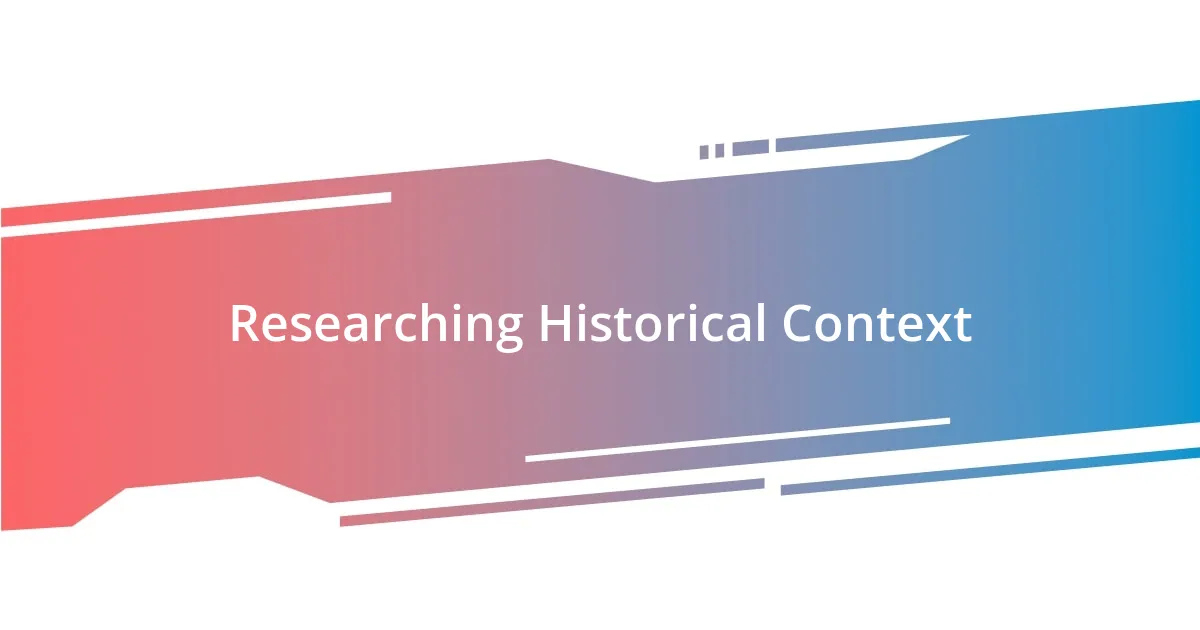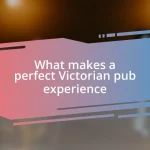Key takeaways:
- Victorian pubs served as essential community hubs, fostering social connections and providing safe spaces for expression amidst daily struggles.
- Researching historical context through newspapers, diaries, and architectural studies reveals the social dynamics and evolution of these establishments over time.
- Engaging with locals and documenting personal narratives help preserve the rich tapestry of pub life, connecting past and present experiences.
- Sharing stories via digital platforms allows for wider audience engagement, transforming individual narratives into collective experiences and preserving them for future generations.

Understanding Victorian Pubs
Victorian pubs were more than just places to grab a drink; they were vibrant community hubs. Picture this: a warm evening, the air filled with laughter and the clinking of glasses as locals gathered to share stories. Don’t you feel that sense of connection to a time when socializing happened face-to-face rather than through screens?
These establishments often reflected the social fabric of the era. They served different classes and professions, each pub creating its own unique atmosphere. I remember visiting a pub that had preserved its Victorian décor, and I could almost feel the echoes of conversations from over a century ago. What kinds of stories do you think those walls have witnessed?
For many Victorians, the pub was a trusted refuge, a place where camaraderie flourished amid the struggles of everyday life. It’s fascinating to think about how these pubs acted as safe spaces where people could express themselves freely. Have you ever walked into a place and instantly felt at home? That’s the magic of a good pub, isn’t it?

Researching Historical Context
Researching the historical context of Victorian pubs involves diving deep into the social and economic conditions of the time. I found that reading contemporary newspapers and journals really brought the era to life. The articles often detailed the events and issues of the day, such as the rise of industrialization, which made me appreciate how these pubs served as retreat points for weary workers.
Understanding the impact of the Temperance Movement was particularly eye-opening for me. This movement aimed to reduce alcohol consumption, leading to the proliferation of teetotal establishments. I recall the feeling of surprise when I stumbled upon a diary written by a pub owner during this transitional period—it truly highlighted the struggles they faced in maintaining their businesses while adapting to the changing social climate.
Moreover, considering the architectural features of these pubs added another layer to my understanding. Many were constructed with distinct styles, like the ornate tiles and intricate woodwork, often reflecting the wealth of their patrons. Walking through a historic pub, I felt a connection to the craftsmanship of the past, imagining the skilled hands that shaped the wood and laid the tiles. Isn’t it intriguing how the physical space can tell so much about the people who frequented it?
| Research Method | Description |
|---|---|
| Newspaper Articles | Insights on daily life, issues, and community events affecting pubs. |
| Diaries and Letters | Personal accounts from pub owners that showcase individual experiences and challenges. |
| Architectural Study | Analysis of design elements that reveal societal values and class differences. |

Techniques for Collecting Stories
When it comes to collecting stories from Victorian pubs, I’ve found that engaging with locals can yield some of the most fascinating tales. I remember sitting at the bar with an elderly gentleman who recounted his upbringing in a pub run by his grandparents. The twinkle in his eye and the warmth in his voice made me feel like I was transported back in time, living those stories alongside him. Listening closely not only preserved the essence of the past but also helped me bond with the community.
Here are some effective techniques for gathering these rich narratives:
- Oral Interviews: Approach regulars and pub staff for informal conversations that capture personal anecdotes.
- Storytelling Events: Attend or organize storytelling nights to invite the sharing of local legends and experiences.
- Community Boards: Utilize flyers or posts in the pub inviting patrons to write down their stories or memories to share.
- Photo Prompts: Bring in historical photos of the pub to spark memories and encourage conversations about the past.
By employing these techniques, I’ve discovered a treasure trove of anecdotes that reveal the fabric of pub life in the Victorian era. Each story enriches the narrative landscape I’m constructing in my own exploration.

Engaging with Local Communities
Engaging with local communities has been one of the most rewarding aspects of my journey. Just the other day, I found myself chatting with a group of regulars in a cozy corner of a Victorian pub. Their laughter filled the air as they shared tales of the pub’s infamous ghost—a spirited figure believed to have been a former landlord. I couldn’t help but wonder: how many layers of truth are woven into that story?
I also recall an unforgettable evening when I hosted a storytelling event right in the pub’s main hall. The energy in the room was electric as locals stepped up to recount their experiences. One gentleman, with a deep, resonant voice, revealed how he met his wife amidst the lively atmosphere of pub games decades ago. His poignant nostalgia became a bridge, connecting past and present in a way that felt genuinely uplifting.
I’ve learned that strong relationships with the community can open doors to stories that might otherwise remain untold. By simply asking questions and showing genuine interest, I discover not just personal histories but also a sense of belonging. Isn’t it remarkable how a pint of beer and shared memories can unite people across generations? Each story I uncover feels like a thread in a larger tapestry, enriching my understanding of both the pubs and the lives intertwined with them.

Documenting Personal Narratives
Documenting personal narratives is an intimate journey. I remember once speaking with a lovely lady who had been coming to the same Victorian pub since her youth. As she shared her memories over a pint, her eyes sparkled with nostalgia, and I could almost see the echoes of her younger self darting around the dimly lit room, laughing with friends. Capturing these moments feels like collecting fragments of history that might otherwise fade away.
One technique that stood out to me was the importance of creating a comfortable atmosphere during these discussions. I often find that when I sit quietly and genuinely listen, patrons open up about their lives in unexpected ways. A gentle prompt about their favorite pub memories can unleash a flood of vibrant tales that reveal the pub’s role in their significant life moments. How many stories lie beneath the surface, waiting for someone to ask the right question?
I also discovered that documenting personal narratives isn’t merely about the stories themselves; it’s about the connections forged through shared experiences. While chatting with a pub owner reminiscing about his family’s history in the business, I felt a profound sense of continuity. Engaging with these narratives, I realized, helps not only preserve history but strengthens community bonds. How incredible is it that a simple conversation can weave together the past and the present, enriching the fabric of our lives?

Preserving Stories for Future Generations
Preserving stories for future generations is a responsibility that weighs heavily on my heart. I recall an evening spent with a passionate group of local storytellers, each sharing tales that danced across the decades. As I listened, I couldn’t help but feel a sense of urgency; these stories, vibrant and alive, deserved to be immortalized. How many voices risk being lost if we don’t take action now?
In my experience, the act of recording these narratives transcends mere documentation. I often find myself transcribing the words of an elderly regular, who recounted her first encounter with the pub when it was just a small, unassuming establishment. Through her laughter and the occasional tear, I realized that preserving these memories offers not only a glimpse into history but also a lifeline for the emotions that shaped those experiences. Isn’t it fascinating how a simple story can transport us through time?
As I sift through photographs and notes, I recognize that these stories will soon become a part of communal lore. Each anecdote I capture feels like a seed planted for future generations to nurture and explore. A young friend of mine recently expressed how intrigued she was by the tales of her great-grandparents, and it hit me then: preserving stories isn’t just an act of remembrance; it shapes the identity of our communities. Will the tales we gather today spark curiosity and pride in those who come after us?

Sharing Stories through Digital Platforms
Sharing stories through digital platforms opens a vibrant avenue for connecting with a wider audience. I remember when I first started sharing the tales I gathered from Victorian pubs on social media. The response was overwhelming; people began to share their own stories in the comments. It felt like a communal gathering where experiences flowed freely, all sparked by the snippets of history I posted. How amazing is it to be part of a digital tapestry woven from the threads of so many individual narratives?
Every time I upload an audio clip of patrons reminiscing about their favorite moments, I feel a rush of excitement. One time, I shared a recording of a spirited debate among locals about the best pub game, and it turned into a lively discussion that crossed across platforms. It reminded me of how stories don’t just exist in isolation; they create ripples that engage others and foster a sense of belonging. I often wonder how many hidden gems are waiting to be uncovered just by sharing a memory online?
Engaging with stories digitally also helps preserve them in a way that feels immediate and accessible. I once created a short video montage combining photographs of historical pub interiors with the voices of longtime patrons telling their tales. Watching those clips circulated gives me chills; it’s as if I’ve opened a window into the past for the world to see. What if those moments capture someone’s imagination and inspire them to visit a place they’ve never experienced? Sharing through these platforms transforms personal narratives into collective experiences that resonate deeply with all involved.















